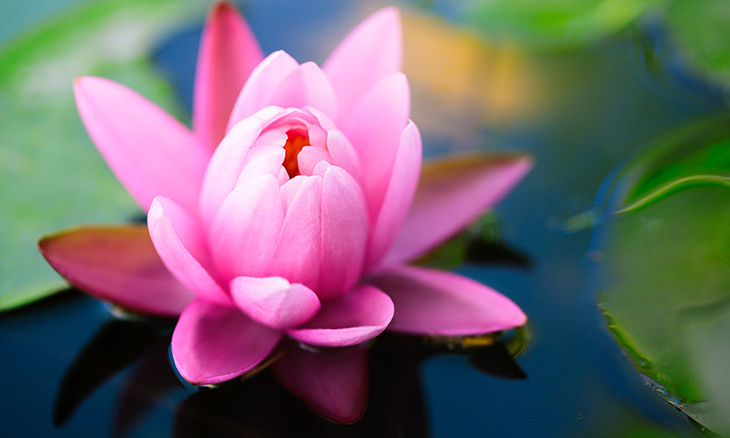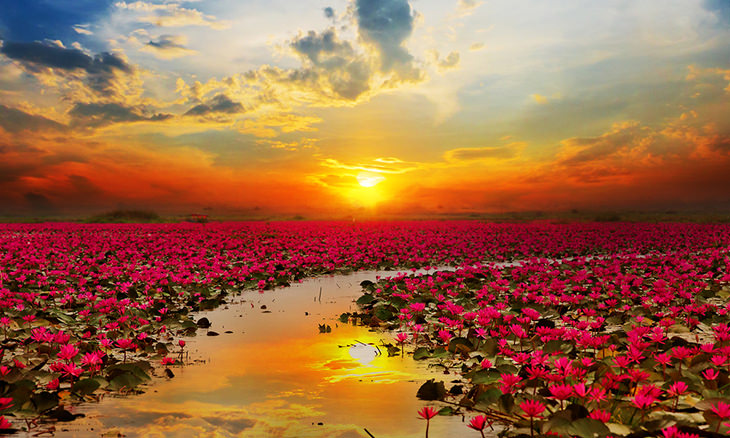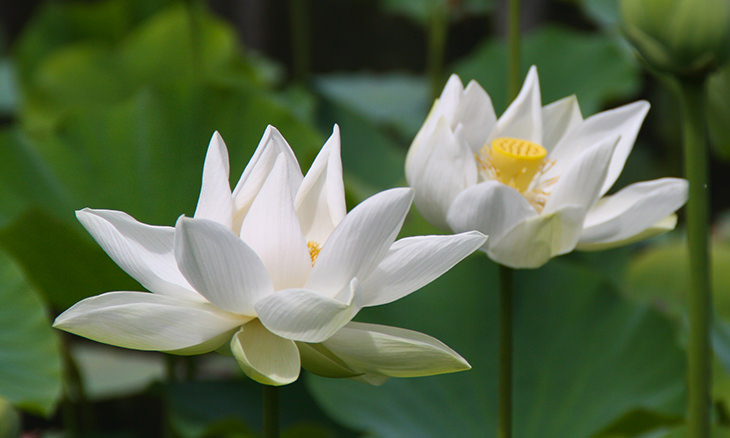
The lotus flower is an aquatic perennial flower that grows on the surface of bodies of water. It’s closely associated with one ancient culture, namely Ancient Egypt, as well as two extant Asian religions – Hinduism and Buddhism. It’s also the national flower of two different nations. Here’s all you need to know about the lotus exotic flower:

• The lotus flower is the national plant of both India and Vietnam. Curiously, it's the pink lotus flower that’s the national symbol for both.
• Despite being only able to reach 49 inches in height, lotus flowers can spread 10 feet horizontally.
• Most parts of the lotus are edible and thus consumed, from the stems to the rhizomes, as well as the flower itself.
• The flower actually opens in the morning and closes again at night.
• Paddle-shaped leaves can reach some 20 inches in width. They also contain air pockets to retain buoyancy on the
surface of a body of water.
• Lotus seeds have been known to retain their ability to germinate after up to 1,300 years of dormancy.
• Dry lotus stamens are often used in the preparation of aromatic tea.
• The lotus is able to maintain a stable flower temperature, unlike other flowering plants.
• Lotuses come in white, red, blue and pink colors. In Buddhism, a golden lotus is a symbol of complete and total
enlightenment.
• More than 740,000 acres of Chinese land is devoted to lotus cultivation, and lotuses are usually cultivated in a crop rotation system with rice and vegetables.

Lotus flowers are excellent for use in wastewater treatment, and that’s because they have the ability to remove polluting compounds and heavy metals from wastewater. This ability is also helped by their ability to grow in variable water conditions and low light intensity.
They are also ideal for use in protein bioengineering processes because they contain thermal-stable proteins characterized by seed longevity used for cell protection and repair under stress. Compounds found in lotus flowers are also used in drug fabrication for human health research.
Lotus rhizomes, leaves, seeds and flowers are used in folk medicines, Ayurveda, Chinese traditional and oriental medicine. Leaves are used for treating hematemesis, epistaxis, and hematuria, while flowers are used for treating diarrhea, cholera, fever, and hyperdipsia. Rhizomes supposedly have diuretic, antidiabetic, and anti-inflammatory properties.
In addition to their uses in various Asian cuisines, lotus pip, lotus leaf, and lotus flower teas are consumed in Korea.

The Hindu deities, Vishnu and Lakshmi, are normally depicted standing on a pink lotus flower. The goddess Saraswati tends to be depicted on a white-colored lotus flower. In addition, Vishnu is also described as the “Lotus-Eyed One”. The lotus flower’s growth from the mud of its origin into a beautiful flower with unfolding petals also signifies divine beauty in Hinduism. Many other Hindu deities are depicted sitting on lotus flowers.
In Buddhism, the lotus represents purity of body, speech, and mind. This is because the flower floats above muddy waters, which represent attachment and desire. The Buddha himself was said to have been born with the ability to walk with lotus flowers blooming everywhere he stepped. The different colors of lotus flowers also have different symbolic meanings.
This video will tell you everything you need to know about growing a large lotus flower successfully at home:

Lotus flowers tend to do best in warmer climates, but that doesn’t mean they can’t handle some shade. The only exception to this rule is desert climates, where it is preferable to cover them in some shade cloth. They need to be kept at a temperature of at least 75°F throughout the three months of summer for them to do well.
Although lotus plants can grow in just 2 to 4 inches of water, they do best in about 18 inches of water, as well as water that’s even deeper. Shallow water is a benefit in cooler climates, because it takes more energy for them to grow, especially during spring. Dwarf lotuses should be grown in water that’s between 2 and 12 inches deep.
In addition, lotus plants are extremely adaptable to different water chemistries, but you need to be wary of growing them in very hard and alkaline water that’s full of minerals. This is because they can accumulate the minerals in the water over time, thus harming the plant. If you’re growing yours in a pot, it’s advisable to flush out any hard water with fresh water to replace evaporation. This is less likely to be a problem in a larger pond, but occasional over-filling can still be beneficial. Ensure that the water you’re growing them in is less 1,000ppm in hardness.

• A lotus plant should only be fertilized sparingly for the first year after it has been planted.
• An established lotus plant can be fertilized every 3 or 4 weeks.
• Ensure that care is taken when inserting fertilizer tabs because the growing tip and new growth can be damaged.
• The plant’s roots must be kept from freezing.
• Cut off the plant’s yellow foliage in late fall and move the plant to the deepest part of the pond.
• If the plant dies during fall, lift its tubers out and store them in a cool, frost-free location until late spring. You can also try storing them in living sphagnum moss to prevent mildew and rot.
Images by Deposit Photos.
Related Articles:
Lotus Flower - The History, Symbolism and how to Grow It